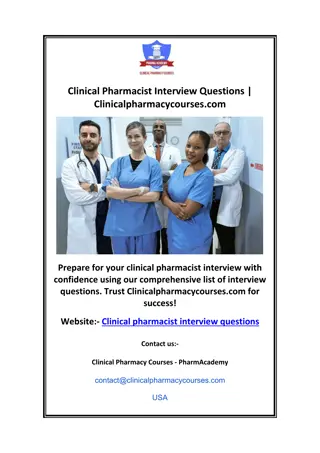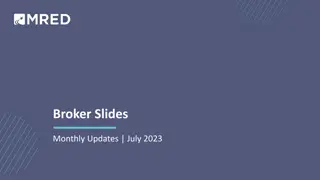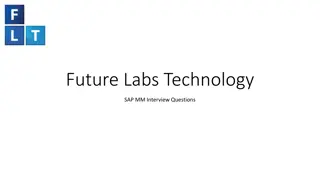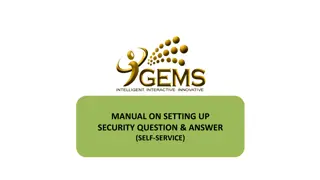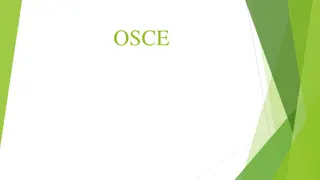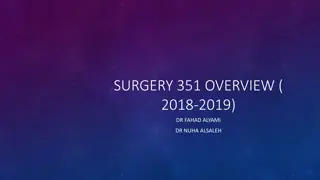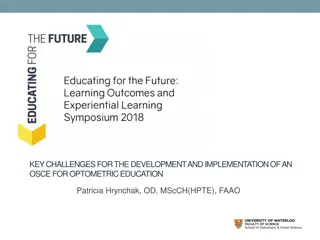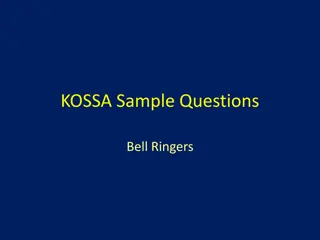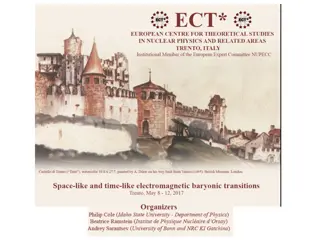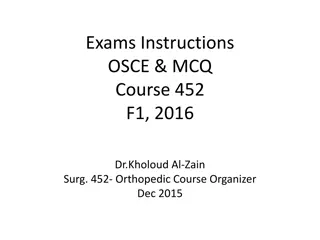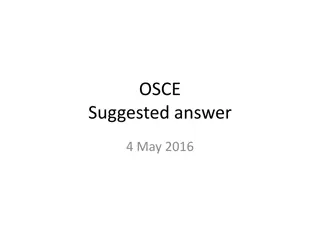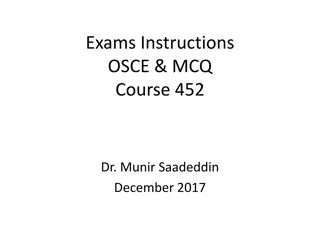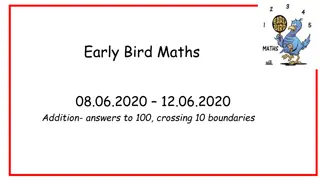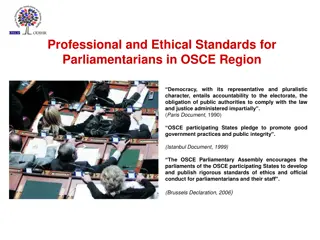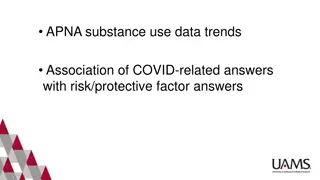JCM OSCE with Answers: July 2023 Case Studies
Dive into two clinical cases presented in the JCM OSCE exam for July 2023. Learn about a 45-year-old female with headache and facial pain and a 37-year-old female with rodenticide ingestion leading to gross hematuria. Explore CT findings, differential diagnoses, imaging investigations, anatomical structures, complications, treatments, and more in these interactive scenarios.
Download Presentation

Please find below an Image/Link to download the presentation.
The content on the website is provided AS IS for your information and personal use only. It may not be sold, licensed, or shared on other websites without obtaining consent from the author.If you encounter any issues during the download, it is possible that the publisher has removed the file from their server.
You are allowed to download the files provided on this website for personal or commercial use, subject to the condition that they are used lawfully. All files are the property of their respective owners.
The content on the website is provided AS IS for your information and personal use only. It may not be sold, licensed, or shared on other websites without obtaining consent from the author.
E N D
Presentation Transcript
JCM OSCE with Answers (YCH) July 2023
case 1 45/F complained of headache and left facial pain for 3 months
1. Describe the CT findings circular lesion, hyperdense, about 2x2cm over left parasellar region mass effect noted with effacement of left temporal sulci no peri-lesional edema 2. What the differential diagnoses? brain tumour like meningioma, astrocytoma aneurysm arteriovenous(AV) malformation
3. What imaging investigations can be used to confirm the diagnosis? MRI brain with MRA DSA (Digital Subtraction Angiogram) CT cerebral angiogram ( in this case, MRI brain with MRA confirmed the lesion is internal carotid artery (ICA) aneurysm in cavernous segment)
4. What are the segments of internal carotid artery (ICA) ? by Bouthillier classification Cervical segment C1, Petrous segment C2, Lacerum segment C3, Cavernous segment C4, Clinoidal segment C5, ophthalmic segment C6, communicating segment C7
5. Why did the patient complain of left facial pain ? the ICA aneurysm in cavernous sinus compress the V1 and V2 6. What are the complications of ICA aneurysm? direct local pressure rupture thrombo-embolic event 7. What are the 2 modalities of treatment? endovascular embolization open surgery with clipping
case 2 37/F complained of accidental ingestion of 1 pack of rodenticide about 1 month ago, attended mainland China s hospital with unknown treatment given, went back Hong Kong 3 days ago, then developed gross hematuria with blood clot for 1 day
1. What would you do next? consult HKPIC to clarify the ingredient of this rodenticide with its packing and for suggestion of management (in this case, PIC comfirmed the rodenticide with ingredient of brodifacoum, which is a superwarfarin ) check clotting profile KUB
2. What is the mechanism of action of brodifacoum ? inhibit the vitamin K epoxide reductase, which is an enzyme for activating/recycling functional vitamin K (vitamin K hydroquinone) for synthesis of active clotting factors 3. What is the half-life? the half-life is 20 to 130 days (weeks to months) 4. What are the clotting factors to be affected factor II, VII, IX and X
5. 2 hours later, INR showed > 8 (PT >120, APTT >120), what would you do? give four-factor prothrombin complex concentrate active and serious hemorrhage should be treated with four- factor prothrombin complex concentrate (preferred, Schulman S. How I treat poisoning with vitamin K antagonists. Blood. 2015 Jan) or fresh frozen plasma start vitamin K1 (oral or intravenous)(it reverses the anti-coagulant effect in12-24 hours, uptodate; this means it can not correct coagulopathy immediately ) may consider to consult urologist
case 3 65/F found loss of consciousness in the morning she had decrease in responsiveness for 3 days
1. Describe the facial clinical features? bilateral peri-orbital swelling puffy face loss of eyebrow hair loss of hair enlarged tongue dry skin
2. Based on these clinical features,what is the likely diagnosis? myxoedema coma(myxedema coma) What are the differential diagnoses ? anaphylaxis with angioedema renal failure with electrolyte disturbance CNS causes like stroke toxicological causes like benzodiazepine overdose
3. What are the risk factors for this condition? elderly over 60 year-old female previous thyroid diseases recent illness or surgery as triggering factor 4. What are the associated complications with this condition? hypothermia respiratory failure cardiogenic shock hyponatremia hypoglycemia
5. What is the mortality rate (even with treatment) ? 30-40% 6. What are the treatments supportive, consult ICU thyroxine: levothyroxine (T4), 200mcg-400mcg i.v. +/- liothyronine (T3) 5-20mcg i.v steroid: hydrocortisone 100mg i.v. treat the triggering illness
case 4 18/ M fell during playing football, landed on outstretched left hand, then complained of left elbow injury
1. Are oblique views be important for elbow injury? Yes, oblique views are standard for elbow injury 2. Describe the x-ray findings anterior fat pad sign and posterior fat pad sign fracture of coronoid process of ulna with mild displacement no radial head fracture
3. What is the mechanism of injury ? distal humerus is driven against coronoid process with varus stress 4. Name the classification of this fracture Regan and Morrey Classification
5. What is terrible triad of elbow? the combination of coronoid process fracture, radial head fracture and elbow dislocation 6. Name long-term complications elbow stiffiness, elbow instability, non-union, mal-union and osteoarthritis 7. What are the 2 modalities of treatment operative : open reduction and internal fixation (for elbow instability) non-operative: hinged elbow brace (initially fixed at 90 , then gradually allow mobilization after 1 to 2 weeks)(to avoid long- arm POP for 4 weeks)
case 5 a 22 month-old boy presented with abdominal pain and vomiting with undigested food for 1 day
1. Describe the x-ray findings? meniscus sign(crescent sign) over left upper quadrant target sign over right upper quadrant absent liver edge sign no dilated bowel
2. What is the likely diagnosis? intussusception what is the pathology? telescoping of a segment of bowel into adjacent segment of bowel 3. What are the risk factors for this condition age between 5 month-old to 5 year-old male (male:female ratio 3:2) previous history of intussusception GI infection
4. What are the significant physical findings in this condition? sausage-shaped abdiminal mass over right upper quarant emptiness over right lower qaurant (Dance s sign) red currant jelly stool 5. What is the most important investigation? bed-side USG what do you look for in this investigation? target sign, pseudokidney sign
6. What are the treatments? pneumatic enema (air enema) (risk of perforation is lower) hydrostatic enema surgery in complicated cases END THANK YOU



